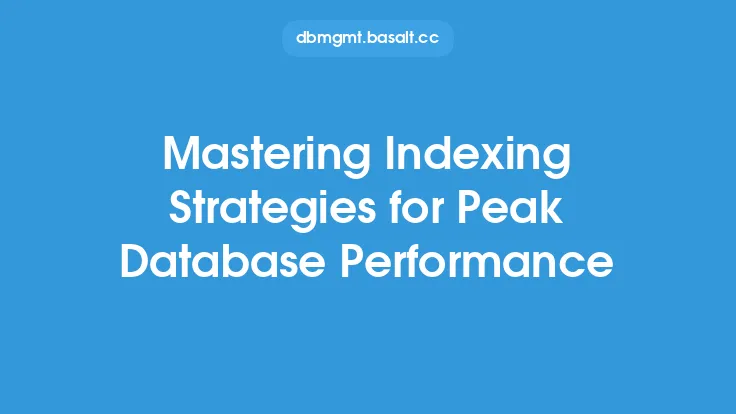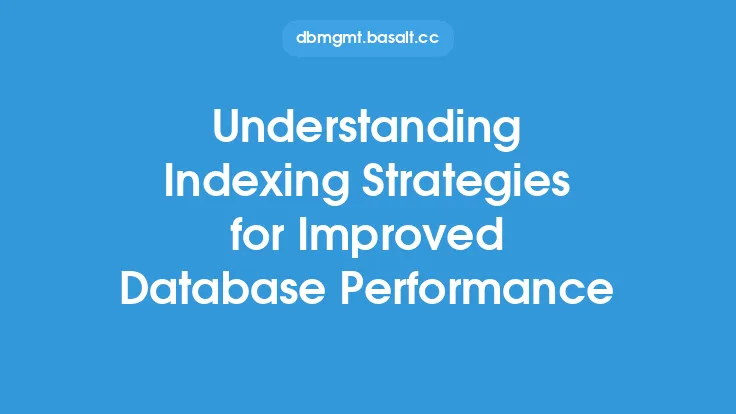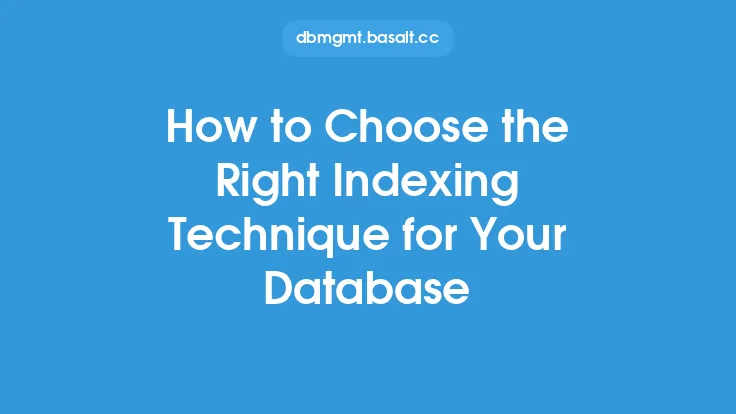When designing a database, one of the most critical aspects to consider is the indexing strategy. Indexing is a technique used to improve the speed of data retrieval by providing a quick way to locate specific data. A well-designed indexing strategy can significantly enhance the performance of a database, while a poorly designed one can lead to slower query execution and decreased overall system efficiency. In this article, we will delve into the world of database indexing, exploring the different types of indexes, how they work, and the best practices for designing an efficient indexing strategy.
Introduction to Indexing
Indexing is a data structure technique that allows the database to quickly locate and retrieve specific data. An index is a data structure that contains a copy of selected columns from a table, along with a pointer to the location of the corresponding rows in the table. When a query is executed, the database can use the index to quickly locate the required data, rather than having to scan the entire table. This can significantly improve the performance of queries, especially those that involve filtering, sorting, or joining large datasets.
Types of Indexes
There are several types of indexes that can be used in a database, each with its own strengths and weaknesses. The most common types of indexes are:
- B-Tree Index: A B-Tree index is a self-balancing search tree that keeps data sorted and allows for efficient insertion, deletion, and search operations. B-Tree indexes are suitable for queries that involve range searches, such as finding all rows where a column value falls within a certain range.
- Hash Index: A Hash index uses a hash function to map keys to specific locations in an index. Hash indexes are suitable for queries that involve equality searches, such as finding all rows where a column value matches a specific value.
- Full-Text Index: A Full-Text index is a specialized index designed for searching large amounts of unstructured text data. Full-Text indexes are suitable for queries that involve searching for specific words or phrases within a text column.
- Composite Index: A Composite index is an index that combines multiple columns into a single index. Composite indexes are suitable for queries that involve filtering on multiple columns.
How Indexes Work
When a query is executed, the database uses the index to quickly locate the required data. Here's a step-by-step overview of how indexes work:
- Index Creation: When an index is created, the database scans the table and creates a copy of the selected columns in the index.
- Index Maintenance: When data is inserted, updated, or deleted from the table, the database updates the index to reflect the changes.
- Query Execution: When a query is executed, the database checks if an index exists that can be used to satisfy the query.
- Index Scan: If an index exists, the database scans the index to locate the required data.
- Row Retrieval: Once the required data is located in the index, the database retrieves the corresponding rows from the table.
Best Practices for Designing an Efficient Indexing Strategy
Designing an efficient indexing strategy requires careful consideration of the queries that will be executed on the database. Here are some best practices to keep in mind:
- Index Columns Used in WHERE Clauses: Index columns that are used in WHERE clauses, as these are the most critical for query performance.
- Index Columns Used in JOIN Clauses: Index columns that are used in JOIN clauses, as these can significantly improve the performance of join operations.
- Avoid Indexing Columns with Low Cardinality: Avoid indexing columns with low cardinality, as these can lead to inefficient index usage.
- Use Composite Indexes: Use composite indexes to combine multiple columns into a single index, which can improve query performance.
- Monitor Index Usage: Monitor index usage to identify indexes that are not being used and remove them to improve database performance.
Indexing Strategies for Common Query Patterns
Different query patterns require different indexing strategies. Here are some common query patterns and the indexing strategies that can be used to optimize them:
- Filtering on a Single Column: Use a B-Tree index or a Hash index on the column used in the filter clause.
- Filtering on Multiple Columns: Use a Composite index on the columns used in the filter clause.
- Sorting on a Single Column: Use a B-Tree index on the column used in the sort clause.
- Joining Two Tables: Use a Composite index on the columns used in the join clause.
Conclusion
Designing an efficient indexing strategy is critical for improving the performance of a database. By understanding the different types of indexes, how they work, and the best practices for designing an indexing strategy, database administrators can create a database that is optimized for query performance. Remember to index columns used in WHERE clauses, JOIN clauses, and sort clauses, and avoid indexing columns with low cardinality. By following these best practices and monitoring index usage, database administrators can create a database that is efficient, scalable, and performant.





